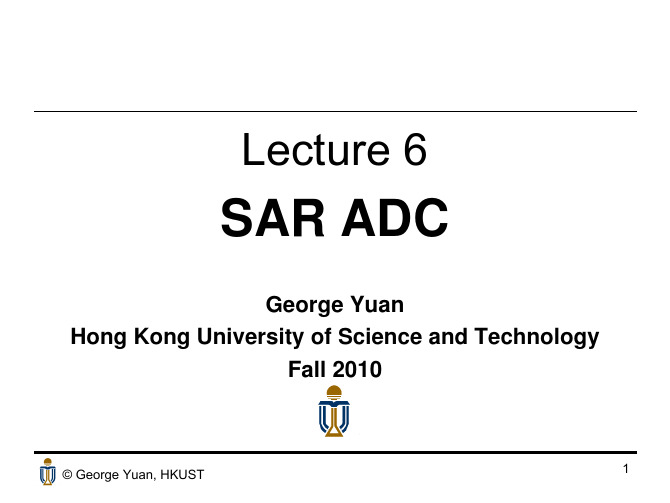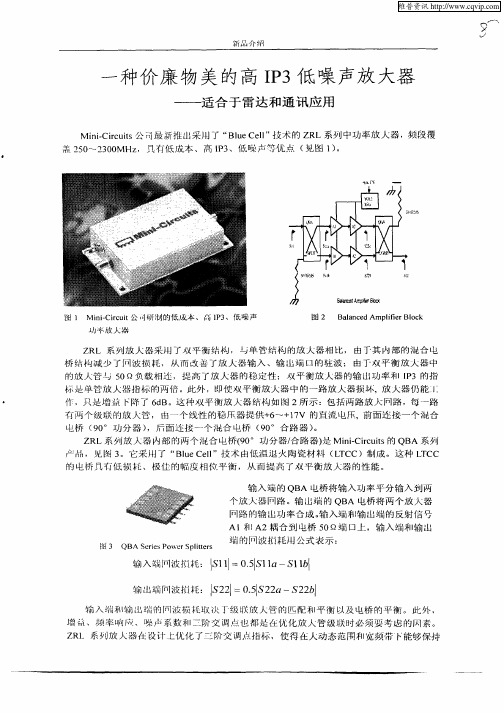A Compact 0.1–14-GHz Ultra-Wideband Low-Noise Amplifier in 0.13um CMOS
- 格式:pdf
- 大小:1.01 MB
- 文档页数:7






1.3~2.2GHz低噪声低功耗CMOS LC VCO的设计陈华;郭桂良;张玉琳;姜宇;韩荆宇;阎跃鹏【期刊名称】《微电子学与计算机》【年(卷),期】2015(0)1【摘要】基于TSMC 0.18μm RFCMOS工艺,设计并实现了一个宽带低功耗低相位噪声的高性能压控振荡器(VCO).为实现1.3~2.2GHz调谐范围,VCO采用7-bit(128根调谐曲线)固定电容阵列,同时也获得了超低的增益,降低了相位噪声.为弱化宽调谐范围带来的增益波动,VCO采用3-bit可变电容阵列来提升低带曲线的斜率,以期与高带一致.为实现每根曲线的宽线性范围,可变电容采用分布式偏置电压技术.为降低相位噪声,还提出了一种输出零偏置架构以及电流源噪声滤除技术.测试结果表明,调谐电压的线性范围为0.2~1.6V;VCO输出频率范围为1.3~2.17GHz;高带调谐曲线叠合超过50%,低带超过80%;VCO增益仅为19 MHz/V;增益波动范围为13~25 MHz/V.当振荡频率为1 312 MHz,1 MHz频偏处相位噪声为-116.53dBc/Hz;当振荡频率为2 152MHz,1 MHz频偏处相噪为-112.78dBc/Hz.VCO功耗电流为1.2~3.2mA,电源电压为1.8V.提出的VCO既能提供51%的频率覆盖,又能实现低相位噪声,已经被成功应用于工业自动化无线传感网(WIA)射频收发机芯片中.【总页数】5页(P24-28)【关键词】宽带;低相位噪声;低功耗;压控振荡器;锁相环;频率综合器【作者】陈华;郭桂良;张玉琳;姜宇;韩荆宇;阎跃鹏【作者单位】中国科学院微电子研究所【正文语种】中文【中图分类】TN752【相关文献】1.宽带低噪声LC VCO及一种新式稳幅电路的设计 [J], 孙文;唐守龙;吴烜;宋莹莹2.低功耗宽带CMOS LC-VCO设计 [J], 肖时茂;马成炎;叶甜春3.数字电视调谐器中低噪声LC VCO的设计 [J], 李壤中;孙文;吴建辉4.26GHz宽带低噪声CMOS LC-VCO设计 [J], 李聪;刘自成;安建5.单片CMOS UHF RFID阅读器中低噪声LC VCO的设计 [J], 何伟;徐萍;张润曦;张勇;李彬;陈子晏;马和良;赖宗声因版权原因,仅展示原文概要,查看原文内容请购买。
超宽带低功耗低噪声放大器芯片
刘莹;王测天;邬海峰;廖学介;王为
【期刊名称】《现代信息科技》
【年(卷),期】2023(7)1
【摘要】介绍了一款基于GaAs0.15μmpHEMT工艺的2~18GHz超宽带低功耗低噪声放大器芯片的设计,给出了在片测试结果。
该芯片采用结合有源偏置和并联负反馈技术的改进型共源共栅放大结构,该结构可以使放大器在超宽带的工作频带范围内实现低噪声、低功耗和较高增益,同时减小放大器性能对工艺波动的敏感程度。
在2~18GHz的超宽带频率范围内,该芯片实测噪声系数≤1.4 dB,增益≥14 dB,且具有3 dB的正斜率,输出P-1功率≥12 dBm,输入输出驻波≤1.6,整个芯片功耗仅为0.15 W,芯片尺寸仅为:1.4 mm×1.1 mm×0.1 mm。
【总页数】4页(P51-53)
【作者】刘莹;王测天;邬海峰;廖学介;王为
【作者单位】成都嘉纳海威科技有限责任公司
【正文语种】中文
【中图分类】TN72
【相关文献】
1.一种宽带低功耗低噪声放大器电路设计
2.基于0.15μm GaAs工艺6-18 GHz宽带低功耗低噪声放大器
3.2.8~8.5GHz全集成高增益低功耗超宽带低噪声放大器
设计4.一种宽带低功耗低噪声放大器电路设计5.一种高增益、低功耗的超宽带低噪声放大器
因版权原因,仅展示原文概要,查看原文内容请购买。
IEEETRANSACTIONSONMICROWAVETHEORYANDTECHNIQUES,VOL.58,NO.10,OCTOBER20102575ACompact0.1–14-GHzUltra-WidebandLow-NoiseAmplifierin0.13-mCMOSPo-YuChangandShawnS.H.Hsu,Member,IEEE
Abstract—Acompactultra-widebandlow-noiseamplifier(LNA)witha12.4-dBmaximumgain,a2.7-dBminimumnoisefigure(NF),andabandwidthover0.1–14GHzisrealizedina0.13-mCMOStechnology.Thecircuitisbasicallyaninductorlessconfig-urationusingtheresistive-feedbackandcurrent-reusetechniquesforwidebandandhigh-gaincharacteristics.Itwasfoundthatasmallinductorofonly0.4nHcangreatlyimprovethecircuitperformance,whichenhancesthebandwidthby23%,andreducestheNFby0.94dB(at10.6GHz),whileonlyconsuminganaddi-tionalareaof8080m2.TheLNAonlyoccupiesacoreareaof
0.031mm2,andconsumes14.4mWfroma1.8-Vsupply.
IndexTerms—CMOS,currentreuse,inductorless,low-noiseam-plifier(LNA),resistivefeedback,ultra-wideband(UWB).
I.INTRODUCTION
INRECENTyears,forthedemandofshort-range(within
10m)andhighdata-rate(upto480Mb/s)wirelesscommu-nications,thestandardofultra-wideband(UWB)wassetupbytheFederalCommunicationsCommission(FCC)in2002.TheFCCauthorizedtheunlicensed7.5-GHzband(3.1–10.6GHz)forUWBapplications.Motivatedbyimplementingthetrans-ceiverswithlowcostandahighintegrationlevel,CMOStech-nologybecomesthemostattractivecandidate.OwingtotherapidprogressofCMOStechnology,manystudiesofCMOSRFintegratedcircuits(RFICs)forUWBapplicationswerepub-lishedinsuccessionwithgoodresults[1]–[6].InanUWBreceiver,thelow-noiseamplifier(LNA)withawidebandoperationcapabilityiscriticaltotheoverallreceiverperformance.ThebandwidthoftheLNAisultimatelylimitedbytheparasiticcapacitancesofthedevices.TwotechniquesforextendingthebandwidtharecommonlyusedtodesignUWBLNAsinCMOStechnology,namely,theinductivepeakingtech-niques[1]–[3]andthedistributedamplifier(DA)topology[5].LNAsbasedonthetwotechniqueswerebothreportedwithad-equatebandwidthforUWBapplications.However,onedraw-backisthatthedesignusuallyemploysmanyspiralinductors,whichoccupyalargechiparea.
ManuscriptreceivedJanuary21,2010;revisedJune17,2010;acceptedJune17,2010.DateofpublicationAugust30,2010;dateofcurrentversionOc-tober13,2010.ThisworkwassupportedinpartbyNationalTsingHuaUniver-sity(NTHU)–TaiwanSemiconductorManufacturingCompany(TSMC)underaJoint-DevelopmentProjectandbytheNationalScienceCouncil(NSC)underContractNSC96-2221-E-007-168-MY2,ContractNSC96-2752-E-007-002-PAE,andContract97-2221-E-007-107-MY3.TheauthorsarewiththeDepartmentofElectricalEngineeringandInstituteofElectronicsEngineering,NationalTsingHuaUniversity,Hsinchu300,Taiwan(e-mail:g9561574@oz.nthu.edu.tw;shhsu@ee.nthu.edu.tw).Colorversionsofoneormoreofthefiguresinthispaperareavailableonlineathttp://ieeexplore.ieee.org.DigitalObjectIdentifier10.1109/TMTT.2010.2063832
Recently,inductorlessdesignforwidebandLNAsinCMOStechnologyattractsmuchattentionbecauseoftheconsiderablyreducedchiparea.Variousapproacheswereproposedforwide-bandLNAdesignwithoutusinganyinductors[7]–[12].Thenoise-cancelingtechniquewasadopted[7]–[9],whichsensedthedominantnoisesourceandcanceleditbyanauxiliaryout-of-phaseforwardpathtolowerthenoisefigure(NF).However,thephaseerrorbecomesdifficulttopredict,andthenoisecancel-lationisnotaseffectiveathighfrequencies.Theresistive-feed-backtechniquewasalsoreported[10]–[12].Withalargeenoughinputtransconductance,theresistive-feedbackLNAcanachieveseveralgigahertzofbandwidth,over10-dBgain,andlessthan3-dBNF,butusuallyunderalargebiascurrent[10]orwithamoreadvancedtechnology[12]needed.Tolowerthepowerconsumption,thecurrent-reusetechniqueisemployedtoen-hancetheinputtransconductance[11].Inthisstudy,acompactUWBLNAin0.13-mCMOStech-nologyisproposed.Basedontheconceptofinductorlessdesign,theamplifierincludesaresistive-feedbackconfigurationandacurrent-reuseinputstage.Onesmallinductorofonly0.4nHisemployedatthemostcriticalnode,namely,thegateoftheinputstageoftheLNAtoenhancethebandwidthandlowertheNFsimultaneously.Comparedwiththecircuitwithoutthein-ductor,thebandwidthisincreasedby23%andtheNFisre-ducedby0.94dB(at10.6GHz)withanadditionalareaofonly8080m.TheproposedLNAachievesawideenoughbandwidthtocoverthewhole3.1–10.6-GHzfrequencyrange,a12.4-dBmaximumgain,anda2.7-dBminimumNFwitha0.031mmcoreareaundera14.4-mWpowerconsumption.Thispaperisorganizedasfollows.SectionIIanalyzesthedesigntechniquesinthisstudyincludingresistivefeedbackandgateinductivepeaking.SectionIIIdiscussestheamplifierde-signindetail.SectionIVpresentsthemeasuredresults.Finally,SectionVconcludesthisstudy.
II.TECHNIQUESOFUWBLNADESIGN